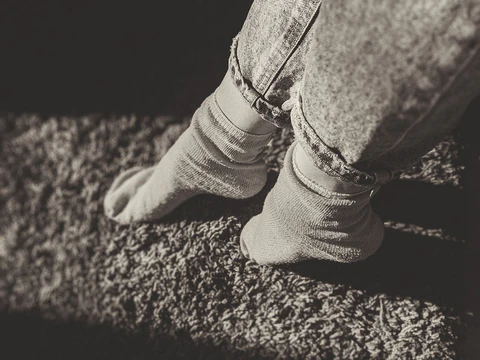
Signs and Symptoms of Diabetic Neuropathy: How Diabetic Socks Can Help
Share
All people with diabetes deserve to live happy, healthy lives. Unfortunately, in addition to tracking insulin levels, diabetics must also worry about potential foot problems such as neuropathy.

What is diabetic neuropathy?
Diabetic neuropathy is nerve damage that causes the feet to feel no heat, cold, pain, cuts, or sores. Amputation is also a common complication of diabetic neuropathy.
Causes of neuropathy include neuroinflammation, uncontrolled hyperglycemic damage to the nerves, genetics, smoking, and more.
Prevent foot problems like diabetic neuropathy by taking care of your feet!
What you need to know about wearing compression stockings for diabetics
Signs and symptoms of diabetic neuropathy
While there are several different types of diabetic neuropathy, we focus on peripheral neuropathy, which affects the feet and legs (and then the hands and arms).
Other types of neuropathy that affect other parts of the body: Autonomic neuropathy (stomach, organs), radiculoneuropathy (thighs, buttocks), mononeuropathy (face) - yes, you may have more than one Types of diabetic neuropathy.
To determine what kind of neuropathy you have, you need to look for signs.
Signs and symptoms of peripheral neuropathy include
- temperature change
- numbness
- tingling or burning sensation
- muscle weakness
- Sensitive to the touch
- severe pain or cramping
Other types of neuropathy can cause similar symptoms in the affected area of the body.
The signs and symptoms of neuropathy develop gradually, so you may not notice any signs until the nerve damage is complete. Symptoms can improve over time, or get worse before they get better, which is why it's important to take care of your body, especially your feet!
How Diabetic Socks Help Diabetic Peripheral Neuropathy
As a diabetic, you should always strive to protect the health of your feet.
Make it a habit to check your feet daily for any cuts, blisters, sores, bruises, redness, swelling -- anything unusual.
Wearing clean, dry, moisture-wicking and loose-fitting socks will help protect your feet from diabetic foot problems such as neuropathy.
Diabetic Compression Stockings: A Guide to Helping You Choose the Best Pair
Diabetic Socks vs Compression Socks: What's the Difference?
Socks have so many uses in the healthcare industry that it can be hard to tell which one you might benefit from.
While you should also seek advice from your doctor or medical professional, we've outlined the differences between diabetic stockings and compression stockings to make your shopping experience a little easier.
Diabetic Socks vs Compression Socks
Diabetic socks are usually loose-fitting and designed to protect your feet from moisture, extra pressure, and injuries such as blisters and ulcers.
Compression stockings fit snugly and are designed to reduce fluid build-up and prevent blood from pooling in the calves and feet of people with circulation problems.
Diabetic socks
Elevated blood sugar levels can lead to foot problems, such as diabetic neuropathy (nerve damage), which can cause you to lose your ability to feel pain, heat, or cold in your feet. They can also affect blood vessels and cause circulation problems that can prevent cuts and ulcers from healing properly.
Fortunately, diabetic socks can help you live confidently without foot problems. Diabetic socks are comfortable, loose-fitting, non-binding socks designed to protect your feet.
Diabetic socks should be seamless, inelastic, and moisture-wicking so you can keep your feet dry (and prevent bacterial growth!). They also provide extra padding for sensitive foot areas to reduce pressure on the feet. Many diabetic socks are only sold in white - so you can easily identify a foot injury or cut when your feet start to loosen. If there is a problem, the white fabric will show immediately.
Compression stockings
Compression stockings are often recommended for people with diabetes and circulation problems that cause swollen feet and legs.
Compression stockings help relieve discomfort and increase circulation, preventing blood from building up in your feet and legs. Diabetic compression stockings have mild to moderate progressive compression, which means the garment's strongest support is at the ankle and gradually decreases toward the top (closest to the knee). For most people with diabetes, compression stockings are primarily used as a comfort precaution.
The benefits of compression stockings for people with diabetes
Wearing compression stockings for diabetes has several benefits.
- Promote proper circulation
- Prevention of blood clots (DVT)
- reduce swelling
- Protect feet from sores, blisters, infections










